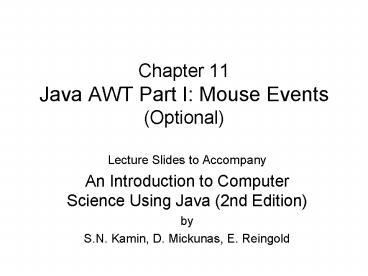Chapter 11 Java AWT Part I: Mouse Events Optional PowerPoint PPT Presentation
1 / 11
Title: Chapter 11 Java AWT Part I: Mouse Events Optional
1
Chapter 11Java AWT Part I Mouse
Events(Optional)
- Lecture Slides to Accompany
- An Introduction to Computer Science Using Java
(2nd Edition) - by
- S.N. Kamin, D. Mickunas, E. Reingold
2
Chapter Preview
- In this chapter we will
- introduce event driven programming
- show how a program can respond to mouse events
(e.g. clicks and mouse movements) - demonstrate how to implement a listener interface
- show how mouse events can be used to build highly
interactive programs
3
Abstract Windowing Toolkit (AWT)
- Part of the Java distribution, but not part of
the Java language itself - AWT is library of classes and methods used by
Java programmers that supported are by the basic
Java runtime libraries - Even though this chapter is labeled optional, it
is not possible to be a complete Java programmer
without understanding the AWT
4
Java Events
- Events are occurrences outside of the program to
which the program must respond (e.g. user key
press) - Event managers are methods that first catch the
event - Listener classes send messages to an event
manager requesting to be notified when a
particular message occurs - Event managers send messages to listeners
notifying them when a particular event occurs
5
Creating Mouse Click Listeners
- Import the java.awt.event package
- In the class header, add the words implements
MouseListener - Send the addMouseListerner(this) message to the
mouse event manager (should be done in the
constructor method) - Define methods mouseClicked, mousePressed,
mouseReleased, mouseEntered, mouseExited
6
Mouse Click Listener Template
- import java.awt.event.
- public class classname implements MouseListener
- // include manager.addMouseListener(this)
- // in some initialization method
- public void mouseClicked (MouseEvent e)
- public void mousePressed (MouseEvent e)
- public void mouseReleased (MouseEvent e)
- public void mouseEntereded (MouseEvent e)
- public void mouseExited (MouseEvent e)
7
Finding Mouse Location
- Inside mouseClicked the argument e of type
MouseEvent can be used to find the location of
the mouse cursor - The call e.getX( ) returns the value of the
horizontal coordinate of the mouse cursor
position - The call e.getY( ) returns the value of the
vertical coordinate of the mouse cursor position
8
Creating Mouse Motion Listeners
- Import the java.awt.event package
- In the class header, add the words implements
MouseMotionListener - Send the message addMouseMotionListerner(this)
to the mouse event manager (should be done in
the constructor method) - Define methods mouseMoved and mouseDragged
9
Mouse Motion Listener Template
- import java.awt.event.
- public class classname implements
MouseMotionListener - // include manager.addMouseListener(this)
- // in some initialization method
- public void mouseMoved (MouseEvent e)
- public void mouseDragged (MouseEvent e)
10
Mouse Motion
- mouseMoved will be called each time the mouse
makes a significantly large movement - mouseDragged will be called instead if thre mouse
button is pressed and the mouse makes a
significantly large movement
11
Listening to All Mouse Events
- Two catch all seven mouse events use the
following class header - public class classname implements MouseListener,
MouseMotionListener - You then need to define all seven mouse methods
mouseMoved, mouseDragged, mouseClicked,
mousePressed, mouseReleased, mouseEntered,
mouseExited

